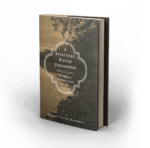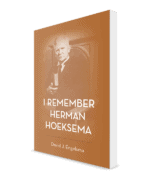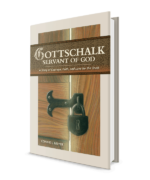Less Than the Least is the memoirs of Rev. Cornelius Hanko’s long, fruitful life of nearly a century (1907-2005). He lived through the two world wars, the Great Depression, the Korean and Vietnam Wars, the rise and fall of communism, and the advent of the space age, and spanned the terms of 18 US presidents, from Theodore Roosevelt to George W. Bush.
From Hull, Iowa to Oak Lawn, Illinois; from Manhattan, Montana to Grand Rapids, Michigan; and from Redlands, California to Hudsonville, Michigan, this memoir tells the story of Pastor Hanko’s life and forty-eight years in the ministry.
Son of Dutch immigrants to America, Rev. Hanko served six pastorates in five states, most notably in First Protestant Reformed Church, Grand Rapids, Michigan (1948-1964), along with Rev. Herman Hoeksema and Rev. Hubert De Wolf. Rev. Hanko poignantly describes the grief caused in the PRC by De Wolf’s heresy and schism (1953).
Pastor Hanko does not just tell his own history. He recalls the story of the Protestant Reformed Churches during the twentieth century. From the perspective of a long-serving pastor, we are given anecdotes and stories of the people Rev. Hanko loved and served in the Midwest and the far West, and we hear a first-hand account of two heart-wrenching church splits—in which Rev. Hanko and many others remained unwaveringly committed to the truth of sovereign grace.
More than this, Less Than the Least follows Rev. Hanko from his childhood, school days and seminary training, all the way to his retirement (1977) and beyond. As well as covering the formation of the Protestant Reformed Churches in the 1920s, it includes his travels to continental Europe, the Middle East, Australia (and the Evangelical Presbyterian Church of Australia) and Northern Ireland (and the Covenant Protestant Reformed Church).
In a very accessible way, this book brings Protestant Reformed church history to life. This delightful book comes complete with photographs.
“The book [on Rev. C. Hanko] was very interesting; a great read.” – Co. Down
Cornelius Hanko: “For a number of weeks in the winter of 1917, schools and churches were closed because of a coal shortage. The authorities maintained that so much coal was being shipped across the sea that there was insufficient coal for public gathering places. Because of the closing of churches and schools, a few of the neighbors came into our kitchen for worship on Sunday mornings. My dad would conduct the service and read a sermon. Thereupon we would all enjoy a cup of coffee and a piece of cake … Then, to make matters worse, the (Spanish) influenza epidemic hit in the winter of 1918-19. Once more schools and churches were closed for six weeks. Almost no one went to work. Nearly every home had one or more sick with the flu. Doctors could not keep up with the calls that came in: they worked day and night. But the worst was that they knew of no cure. They tried the usual medicines, and they tried the most caustic medicines, all to no avail. Hundreds died. Funeral services were held outside. Very few went to the cemetery. A little girl in our neighborhood died also. Her coffin was placed by the front window for the neighbors to see. The minister preached the funeral sermon in the street. A gloom hung over all. Everyone wondered, ‘Will it strike us next?’ There were some homes in which the whole family was stricken, and one home in which there were five deaths. My future mother-in-law, Mrs. Alida Griffioen, gave birth to a child in a room shut off by sheets while others in the family had the flu. Ministers were in a quandary regarding what to do. Rev. Groen was so afraid of catching the flu that he refused to visit anyone. Rev. Peter Jonker Jr. of Dennis Avenue Christian Reformed Church was out almost day and night visiting the sick. He placed a ladder next to an upstairs window in order to visit someone upstairs. He wore himself out to the point that he could hardly preach. The consistory allowed him to preach old sermons for a while. Our family was spared. We sat at home, trying to seek a bit of entertainment among ourselves. But sitting home day after day can grow very wearisome. I remember walking along Wealthy Street just to get out, but the streets were void of pedestrians. The street was ‘like a painted ship on a painted ocean.’ It hardly seemed real. The break came on Sunday, when we had our home service in the morning. To prevent further spreading of the sickness, no more than seven people were allowed to meet together; but we did invite in some neighbors. Those were times when prayer was no longer a mere formality, but a cry of the anxious soul pleading for the sick and bereaved” (Less Than the Least).









